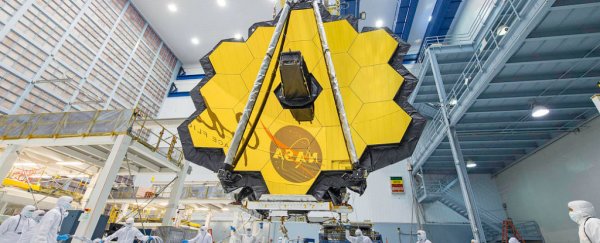The science community is getting a very long-awaited Christmas gift this year – the much-delayed launch of the James Webb Space Telescope!
The successor to the much-loved Hubble, the James Webb Space Telescope, or JWST, was originally scheduled to be launched in 2007. Now, 14 years later, all systems seem to finally be ready to go.
JWST is scheduled to launch at 12:20 UTC (07:20 EST) on Saturday 25 December. You can bet we'll be watching it live and posting as soon as we have confirmation the launch has happened.
You can watch along with us right here on the NASA livestream:
Check it out – NASA photos from December 24 show the telescope is actually on the launchpad!
 (NASA/Bill Ingalls)
(NASA/Bill Ingalls)
The space telescope isn't visible in this photo, but NASA assures us it's safely tucked inside the Ariane 5 rocket that it'll ride into space.
"NASA's James Webb Space Telescope … has arrived at its final location on Earth: the Arianespace ELA-3 launch complex at Europe's Spaceport located near Kourou, French Guiana," NASA wrote in an update.
Rocket: fueled ✅
— NASA Webb Telescope (@NASAWebb) December 25, 2021
Webb’s launch vehicle, an @ariane5 rocket, is all fueled up. Launch is still scheduled for no earlier than 7:20 am ET (12:20 UTC). Read more: https://t.co/AEKIjTSF7j pic.twitter.com/Gunva2rJ2z
The telescope features its famous 6.5-meter-wide (21 feet) primary mirror consisting of 18 gold-plated segments, which will all be folded down into the nose cone for launch.
It's safe to say a lot of people will be holding their breath during the launch. The mission has been called the "most expensive astronomical gamble in history".
This is it: our last moments before the Webb telescope, an international partnership between @NASA, @esa, & @csa_asc, takes off to #UnfoldTheUniverse.
— NASA Webb Telescope (@NASAWebb) December 25, 2021
Join people from around the world in wishing us luck for our launch below! 👇 pic.twitter.com/9ACvQNfz0K
After a 29-day journey, Ariane5 will drop JWST into its position, around 1.5 million kilometers from our planet. There, hanging in a stable spot where the gravitational pulls of Earth and the Sun cancel each other out, the telescope will be able to observe the Universe in more detail than we've ever seen before.
The telescope will primarily make observations in infrared, while Hubble works mostly in optical and ultraviolet wavelengths. This means JWST will be able to pick up things that are too distant, cold, or faint for Hubble to see.
In theory, JWST would be able to detect a heat signature of a bumblebee from Earth if it was as far away as the Moon.
The things we'll learn from JWST are set to overhaul our understanding of the Universe, and frankly, we can't wait.
Good luck, little telescope. We're all rooting for you.
